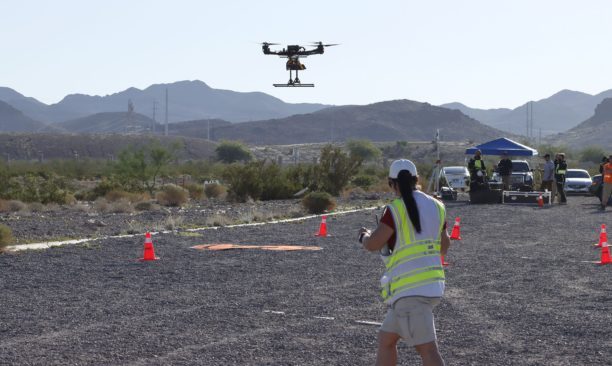
Commercial UAV Expo Outdoor Flight Demos kicked off bright and early in Nevada last Tuesday. Customers, operators, press and the curious joined hosts Sundance Media Group and KukerRanken for a sold-out program of flight demos, held at the nearby Henderson Equestrian Center.
Continue reading below, or listen:
Seven vendors brought aircraft and pilots to the stunning high desert venue to demonstrate their unique characteristics and the newest developments. “As you’ll see, there is nothing like witnessing these drones in action,” said Lee Corkhill of Commercial UAV Expo – and we agree.
Here’s what companies demonstrated at this year’s Commercial UAV Expo Outdoor Flight Demo.
(Credit where it’s due: photos and collaboration on this story greatly appreciated, from drone media pro John Gastaldo and UAV Pilot Paul Rossi of Nine Ten Drones.)

Frontier Precision was up first, with Wyatt Robbins and Sean Muldoon flying the FreeFly AltaX and showcasing YellowScan Voyager LiDAR payload. Frontier performed a mostly automated, simulated LiDAR mission. Flying at 10 m per second, Alta X has a 75 pound max payload and is Frontier’s preferred platform for LiDAR. “That’s because of the reliability, and the heavy payload capacity.”
“These drones were built for cinema,” Robbins explains. “That translates really well to LiDAR, where you want limited vibration for the best data.” Frontier has also upgraded the landing gear, and introduced a custom battery case.

Seeker comes in a transportable shipping case, with snap together wings. The team of operators put it together in about 5 minutes, and can change a battery in one minute – but Seeker can fly for almost 4 hours without a battery change. While it’s an amazing craft for first responders and search and rescue use cases like the LifeSeeker application, the platform is flexible enough to incorporate different payloads and the company is continually developing new capabilities.
Skyfront demonstrated the Flying Perimeter 8 Hybrid Electric drone, which holds a world record for flight endurance at 13 hours. “The premise of our company was to solve the battery problem,” said Skyfront CEO Troy Messler. “When you solve the endurance problem, that dramatically increases the scope of what you can do.”
The hybrid electric propulsion drone offers a 3 hour flight time in its standard configuration equipped with a LiDAR payload, and can carry a max payload of 22 pounds for one hour. The construction design has been carefully engineered to lower costs and barriers to deployment, including the operational costs of shipping – the Perimeter ships in two 50-pound cases, costing about $250 on a commercial airline – and eliminates the complex battery management problem.
Autel’s John McBride demonstrated Autel‘s signature fixed wing, the Dragonfish. The eVTOL can be launched and recovered in a confined space, and can be used for a variety of ISR and public safety applications due to the extended range: search and rescue, reconnaissance, and more. “We really wanted to just demonstrate how easy it is to use,” said Maxwell Lee, Autel Robotics President. “It launches and flies really easily, and just does its job like it’s supposed to.”
That reliability and ease of use is critical functionality for the Dragonfish’s customer base. Dragonfish was used by Lee County Sheriff’s department to locate fugitive Brian Landry in the Carlton Reserve during the highly publicized Gabby Petito tragedy earlier this year.
The Highlander Operations Center means that pilots no longer have to plan the mission – operations managers are able to build, save and automate both recurring and ad hoc missions. Operations managers can see their assets in real time, monitoring the flight profile. As Volatus has received multiple significant BVLOS waivers from Canada’s aviation authorities, including an SFOC to fly across the country, RFCS becomes immediately relevant for their customers.
Marketing Manager Alex Craig described the function: “It takes off like a rocket,” he said, “and then goes into cruise mode and flies like a plane.” It’s an elegant aircraft with an elegant flight – built with failsafe features and safety in mind. Before flight, the drone quickly executed a thorough checklist, most of which was automated. The drone has only four moving parts. “The advantage to that is very minimal construction complexity,” explained Craig. “There isn’t much that can go wrong.” The fully automated flight landed within 1 meter of the takeoff spot – with no input from the pilot.
Skydio Solutions Engineer Matt Boerwinkle worked with the crash reconstruction unit of the Illinois State Police for 25 years. “Time on scene is critical for safety,” Boerwinkle pointed out. “Traditional methods take 2 – 4 hours: we’re down to about 35 minutes. [Skydio X2] is able to do it quickly, safely, and autonomously.”
The Blue sUAS platform is designed to be flexible. “Our application is modular, so we can integrate. It offers unparalleled flexibility.”
“We built our drone as a platform,” says Sakaki. “A UAS is the sum of all of the parts that create value.”
The Commercial UAV Expo Outdoor Flight Demos took place on a 118 degree day. Drone expert Douglas Spotted Eagle and his team at Sundance Media Group, Commercial UAV Expo, and all of the hosts and vendors did an amazing job setting the scene for a fun, safe and successful show.
Miriam McNabb is the Editor-in-Chief of DRONELIFE and CEO of JobForDrones, a professional drone services marketplace, and a fascinated observer of the emerging drone industry and the regulatory environment for drones. Miriam has penned over 3,000 articles focused on the commercial drone space and is an international speaker and recognized figure in the industry. Miriam has a degree from the University of Chicago and over 20 years of experience in high tech sales and marketing for new technologies.
For drone industry consulting or writing, Email Miriam.
TWITTER:@spaldingbarker
Subscribe to DroneLife here.
